

Social Media in Rulemaking – an Example: The RegulationRoom partnership between CFPB and CeRI CFPB CeRI Whitney Patross Cynthia R. Farina Counsel, Faculty Director, Office of Regulations RegulationRoom project
RegulationRoom home page
Topic post (on landing)
Topic Post (selecting § 2 text with comments)
To see more RegulationRoom.org – past rules still visible: CFPB mortgage rules 4 USDOT rules PlanningRoom.org – non ‐ rulemaking discussion: Revising the National Health IT Strategic Plan (ONC/HHS)
Social Media and Rulemaking: Making the tools work for your agency ACUS Social Media Workshop September 17, 2013 CeRI Cynthia R. Farina McRoberts Professor of Research in Administration of the Law Faculty Director, RegulationRoom project
In the social media toolset • Facebook, LinkedIn • Twitter, YouTube • Ideascale, Quora • Tumblr, Wordpress, Google Moderator • MixedInk, Wikispaces
Basic rules on using tools 1. Know what you’re trying to do. 2. Take account of the facts of life. 3. Recognize the role of human effort.
1. What are you trying to accomplish? Using social media is not an end in itself. A democratic government should not actively solicit public participation that it does not value.
Sophisticated Interested Members Missing Stakeholders Unaffiliated Experts stakeholders of the Public Types of Potential Directly affected by Directly affected by proposed rule (either proposed rule (either Scientific, technical or Rulemaking because their conduct because their conduct other professionals Individuals who self ‐ would be regulated or would be regulated or who are not direct identify as interested because they would Participants & Who they are because they would stakeholders, and not in the proposal, but directly benefit); directly benefit); do not employed or retained are not in the previous experienced in Their Likely participate in RM or by a stakeholder in groups interacting with the other agency policy this matter agency in RM and other interactions Capabilities contexts Small trucking company Researchers on driving Trade association of owners; drivers; fatigue or traffic large trucking travelers with accident prediction Members of the Examples companies; large disabilities; consumers models; accessible driving public mortgage lenders; major who went through designers consumer foreclosure; community airlines behavior researchers bank officials Possibly general Awareness of Typically low, but awareness in highly relevant High Typically, low might vary with field politically salient RM; ongoing otherwise, low to and particular rule rulemakings nonexistent May have patchy Understandi knowledge of regulations ng of RM that immediately affect Hard to predict; likely process and High; often “repeat them; unlikely to dependent on field Low to nonexistent larger players” understand RM process and particular rule regulatory or larger regulatory environment environment Ability to comprehend High; often have staff Very low on meaning and that specialize in Low on deciphering High for parts directly deciphering NRPM and implications regulation; likely to have NPRM and supporting relevant to their supporting of agency’s in ‐ house or hired legal cost/benefit projections expertise cost/benefit proposal and technical experts projections without help Low; likely to have relevant situated Ability to knowledge but produce High (already have Likely high for parts communication is effective access to the required relevant to their Very low impeded by lack of comments help) expertise knowledge of RM without help process or larger regulatory context
2. Don’t forget what you know about the world and human behavior Example: The case of responsive commenting
2. Don’t forget what you know about the world and human behavior Example: The case of responsive commenting The lesson : The right social media tools can provide opportunities for desired new behavior (or make undesired behaviors more difficult), but by themselves they are unlikely to alter incentive structures and transform familiar behavior patterns
3. Technology must usually be partnered with human effort Example: Reducing information overload
Sample triage & signposting
Sample: Information layering
Resources GSA Social Media Navigator • http:// www.gsa.gov/portal/category/101299 Social media providers with TOS agreements • http://www.howto.gov/social ‐ media/terms ‐ of ‐ service ‐ agreements Center for Digital Government Excellence – Digital University; weekly • Digital Digest, and a lot more http://www.gsa.gov/portal/content/142785 Usability .gov (HHS): Best practices and guidelines for more user ‐ friendly • Web design http://www.usability.gov/about ‐ us/index.html The Federal Plain Language Group • http://www.plainlanguage.gov/index.cfm
Sample: Role of moderation
Recommend
More recommend